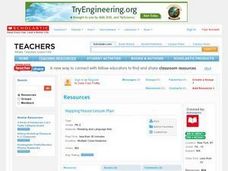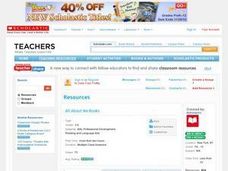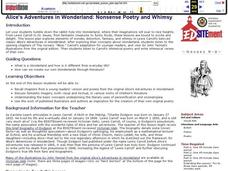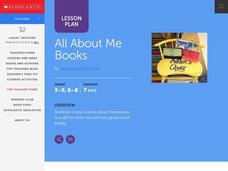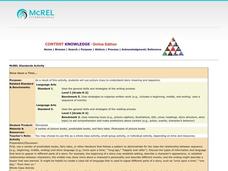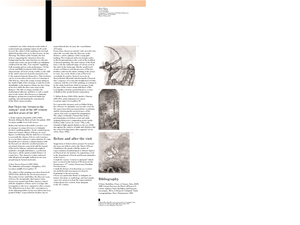abcteach
Literature Circles Planner
Here is a literature circle activity for students to plan an effective group meeting. Instructions are given to answer 10 questions. This form may be used for every book the group reads.
Curated OER
Dr. Seuss Settings
In this literature response activity, learners choose a Dr. Seuss book, and think about the fantasy setting. They then answer 10 questions about the setting, and illustrate it.
Curated OER
Goldilocks and the Three Bears
Students complete a variety of activities related to story of "Goldilocks and the Three Bears" as written by James Marshall. They retell the story using flannel board pieces, discuss alternative endings for the story, and create...
Curated OER
Mixing Colors with "Little Blue and Little Yellow"
Learners mix colors to make new colors. In this color mixing lesson plan, students listen to Leo Lionni's Petit Bleu et Petit Jaune, before retelling the beginning, middle, and end of the story. They watch as the teacher mixes food...
Curated OER
Sharing African Culture
Students investigate African American culture by reading aloud an African folk tale and illustrating the tale. They use their illustrations to create a book or a bulletin board that retells the folk tale.
Curated OER
The Common Core Literacy Standards - Grade 3 Posters
Brighten your third grade classroom with this series of colorful Common Core displays. Including all of the English Language Arts standards and substandards, each with supporting illustrations and examples, this resource provides clear...
Curated OER
Napping House
Read The Napping House and describe the visual characteristics of the illustrations. In this perspective lesson, learners identify color elements. They recognize that the text is repetitive and find patterns in the literature that will...
Curated OER
Martin Luther King Jr.
After listening to a story about Martin Luther King Jr., first graders answer questions about the text. They discuss the importance of the illustrations, identify the beginning, middle, and end of the story, and complete a writing...
Curated OER
Information Problem Solving
Students present information about an author of young adult literature using a HyperStudio stack.
Curated OER
Young Readers Make Inferences with Little Bear
Maurice Sendak’s illustrations reveal implicit truth in the classic children's book Little Bear.
Curated OER
All About Me Books
Students examine literature of emergent readers, categorize books into types of literature common for primary readers (wordless, pattern, alphabet, number, rhyme, etc.), and write a book about themselves to give as gifts to their new...
Curated OER
Alice's Adventures in Wonderland: Nonsense Poetry and Whimsy
Primary learners are introduced to Lewis Carroll's whimsical poetry. They read "The Nursery Alice" Carroll's adaptation for younger readers, view story illustrations, listen to poetry and write whimsical verses of their own about food.
Curated OER
All About Me Books
Young authors write books about themselves using one of the identified types of literature and the writing process. They identify the common characteristics among the books in each group, edit, and gift their books to a younger student.
Curated OER
CAN WE SWITCH GENDERS OF STORY CHARACTERS?
Analyze characters and stories to identify stereotyping. Learners will examine the concept of character gender to evaluate bias in classroom story books. They are asked to read a story or play and change the gender of the character to...
Curated OER
If the World Were a Village...
Your class members explore concept that the world is a large place, examine how statistics can be used to help in understanding the world and its people, and create illustrations or graphs of statistics found in the award-winning...
Curated OER
Once Upon a Time...
Model for emergent readers how to write a story by interpreting picture clues. For guided practice a second book is used, and then pupils work independently or with an adult to write their own stories based on illustrations.
West Corporation
Making Inferences – Use Your Mind to Read!
How can you tell if someone is happy? The lesson works with elementary and middle school scholars to activate their schema and pay attention to details to make inferences in their daily lives, poetry, and other literature. Cleverly...
Utah Education Network (UEN)
8th Grade Poetry: Narrative Poem
The first lesson of a five-lesson unit designed for eighth graders has class members reading and watching a video of Edgar Allen Poe's narrative poem, "The Raven." They then craft their narrative poem, illustrate it, and share their work...
Curated OER
The Green Truck Garden Giveaway
Young scholars read "The Green Truck Garden Giveaway" and explore the hobby of gardening. After observing illustrations in the book, students predict possible events in the story. They discuss gardening and write a story about a...
Curated OER
A Modest Proposal: Irony Made Understandable with Rock and Roll
Who doesn't love music? Poems and songs will engage your high school class in a discussion about irony. Use songs like "Rockin' in the Free World" or "Born in the U.S.A." to illustrate the ironic point of view. Print the lyrics so...
Curated OER
References to Antiquity in Visual Arts (1848 - 1914)
Examine the Latin and Greek language and civilization during the 19th century by exploring the mediums available then. Students examine scenes related to Greek and Roman literature and compare and contrast them.
Curated OER
Reliving History through Slave Narratives
Helpful for an American literature or history unit, this lesson prompts middle schoolers to examine slavery in the United States. They read slave narratives that were part of the Federal Writers' Project and then conduct their own...
Curated OER
James and The Giant Peach Vocabulary Building Activities
Reading literature is one of the best ways for kids to build a strong vocabulary while honing in on their comprehension skills. These vocabulary activities go along with the wonderful book, James and the Giant Peach. The children will...
Curated OER
The Name Game
Students identify acts of philanthropy in different works of literature. They idenify and illustrate examples in colonial America. They also read "Miss Rumphius" on how they can make the world a more beautiful place.


